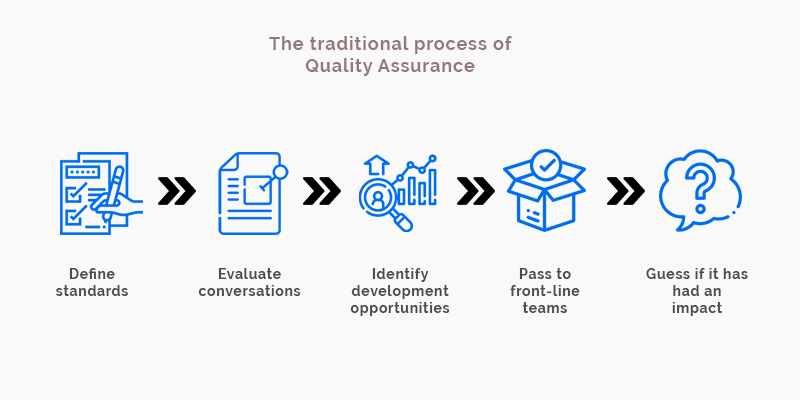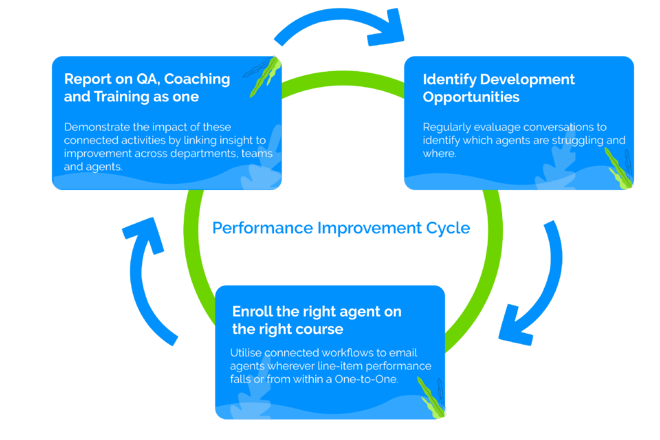Right now, there’s a gap developing between your agents current skills and rising customer expectations.
As self-service and chatbots take care of easy, low-value inquires, your human agents are picking up increasingly complex interactions at a growing rate. These interactions are now happening over multiple channels, with agents having to keep up with constantly changing internal processes, tools and technology.
Whatsmore, in an internet-fueled world, customers are now more clued up than ever before about the products they buy, and expect your Agents to be able to keep up.
If you aren’t ready to train your agents through this, the gap will only get wider.
We know what you’re thinking, and that’s “how are my QA team going to fit this in alongside the considerable list of tasks we have already?”
We get it. QA teams are busy enough already. You’re probably evaluating like crazy to hit your targets, all whilst running calibration sessions and producing more reports than you ever thought possible before you took this job.
But…QA’s role in contact centres is rapidly evolving due to new technology and the ways of working it opens up. In terms of the insight you can offer the business, that’s great news. And, if adding e-learning to your to-do list seems a little daunting at this very minute, don’t worry – e-learning is more an evolution of your workload than an addition to it.
Below, we’ll give you a whistle stop tour of how QA has traditionally worked, how a raft of new tech will affect that role and where exactly e-learning comes into it.
QA The Old Fashioned Way
Traditionally, the sole responsibility of QA teams has been to monitor the interactions your frontline agents have with customers and evaluate their success.
This means that QA teams have always been essential in generating performance data, but their involvement and influence in how identified development opportunities are acted on has been somewhat limited. Evaluations are shared with operational leaders, team leaders and line managers, and it’s up to them how they use that data from then on.

If you work in a small contact centre, it’s easy enough for the QA team (and other senior stakeholders) to see whether this data is being acted on. As headcount expands, however, things get more tricky because:
- Your QA team has more interactions to evaluate, and less visibility into how the QA data they generate is being used.
- Lags in communication with training teams mean that agents continue to be trained based on outdated information.
As a result, silos quickly form, leaving QA teams struggling to demonstrate their impact to senior stakeholders. This can result in indifference to the role QA plays in the contact centre, if not an outright dismissal of it. Despite the vast amounts of potentially useful data they generate, QA teams struggle to justify their need for resources, and sometimes their existence itself.
The Value QA Teams Offer Is Changing
Speech and text analytics software has now reached the point where it can help automate the evaluation of most customer interactions. This means your human evaluators only need to evaluate the interactions that matter.
Of course, human evaluation is still important and will always play a role in your QA team’s day-to-day activities – but this will be increasingly restricted to evaluating those interactions where development opportunities lie or those that present greater risk (ie: where a sale has been made, where a vulnerable customer has been identified)
Must read: The Ultimate Guide to Contact Centre QA
This lifts a huge time burden for your QA team. Of course, one option is always to reduce headcount. A more effective approach, however, is to reinvest this time into activities that offer your contact centre more value – and the real value QA teams will offer going forward is ensuring that the insight they generate is acted on and enables teams to improve their skills, knowledge and behaviour.
You’ll be able to influence genuine performance improvements across the contact centre as a result. Soon enough, your QA team will become central to providing a first-class customer experience rather than something the higher-ups keep in place for risk mitigation and compliance reasons.
So, how do you start to expand your QA team’s remit outside the traditional confines of monitoring and evaluating agent interactions?
It starts by redefining what Quality Assurance means and by closing the loop between Quality Assurance, Training and Performance Improvement.
We call this ‘closing the loop’ on performance improvement because it bridges the divide between frontline teams and QA in a way that traditional QA platforms don’t.
As a result, Contact Centres are empowered to move beyond a lineal Quality Assurance programme and instead establish a culture of continuous improvement across the board.
Practical examples may include changing the job titles of evaluators from Quality Analyst to Quality Coach and/or trainers.
Out With the Old, In With the New
Here’s a handy before/after snapshot of what your QA team’s activities could look like, if you implemented this approach:

| Before closing the loop, QA focuses on… | After closing the loop, QA focuses on… |
| Evaluating enough interactions to hit QA targets | Identifying improvement areas based on QA data |
| Planning and running calibration sessions | Ensuring supervisors are making the most of QA-generated insights |
| Reducing the time it takes to evaluate an interaction | Developing a culture of continuous improvement |
| Producing QA reports (which may or may not be seen by senior stakeholders) | Demonstrating the impact of QA data to senior stakeholders in the organisation |
What Are The Long-Term Benefits Of Closing The Loop?
Where does the removal of data silos, increased visibility over the use of QA data and more personalised performance management lead? We’re glad you asked!
The approach means that QA shifts from ‘cost centre’ status to a department that adds genuine, tangible, measurable value to your organisation. But it goes a lot further than that:
- You identify underperformance and knowledge gaps faster – on both an individual and an organisation-wide level. This is because you remove data silos between departments and open up the possibility for integrated workflows. For example, using real-time data from customer interactions, you can ensure that the right agent is getting the right training at the right time and see how their training results correlate to Quality Scores.
- Your agents improve faster, thanks to relevant, real-time feedback, up-to-date training materials and targeted feedback and coaching.
- You reduce training costs by making training more efficient – you only enroll agents on the training the data says they need and avoid wasted effort.
Overall, your customer experience improves significantly as a result. To finish where we started, QA data helps eliminate that training gap we mentioned at the start, helping to create a team of empathetic frontline agents with the skills to deal with increasingly complex interactions.
Do you want to close the loop? Introducing EvaluAgent LMS.
EvaluAgent LMS empowers trainers and learners to improve skills and increase knowledge via engaging online training, integrated workflows and comprehensive reporting.
https://play.hubspotvideo.com/v/755928/id/52750811149?renderContext=onload-placeholder&parentOrigin=https%3A%2F%2Fwww.evaluagent.com&pageId=52287919763#hsvid=9b5fe1f2-1df9-4803-a799-c94999e14e22&t=1659967658458
It allows Learning and Development (L&D) & QA teams to create and quickly deploy online lessons, quizzes and learning paths. Fully benefiting from EvaluAgent’s connected workflows, the resulting training content can be assigned via actions, one-to-one meetings and coaching sessions. Unlike other solutions, training content can be assigned automatically from EvaluAgent’s reporting suite based on performance related triggers you configure.
Combining high quality interactive training material with leader boards and gamified recognition ensures knowledge retention and learner motivation is maximised. At the same time, lesson tracking and compliance results helps demonstrate everyone is fully committed to a culture of continuous improvement.
Comprehensive reporting ensures leaders have an up-to-date view of the volume and effectiveness of training across the entire business – effectively comparing “outputs” to “inputs” to help demonstrate a clear return on investment.
This more integrated and engaging approach to training will help teams to develop and apply enhanced skills and knowledge faster and cheaper.




